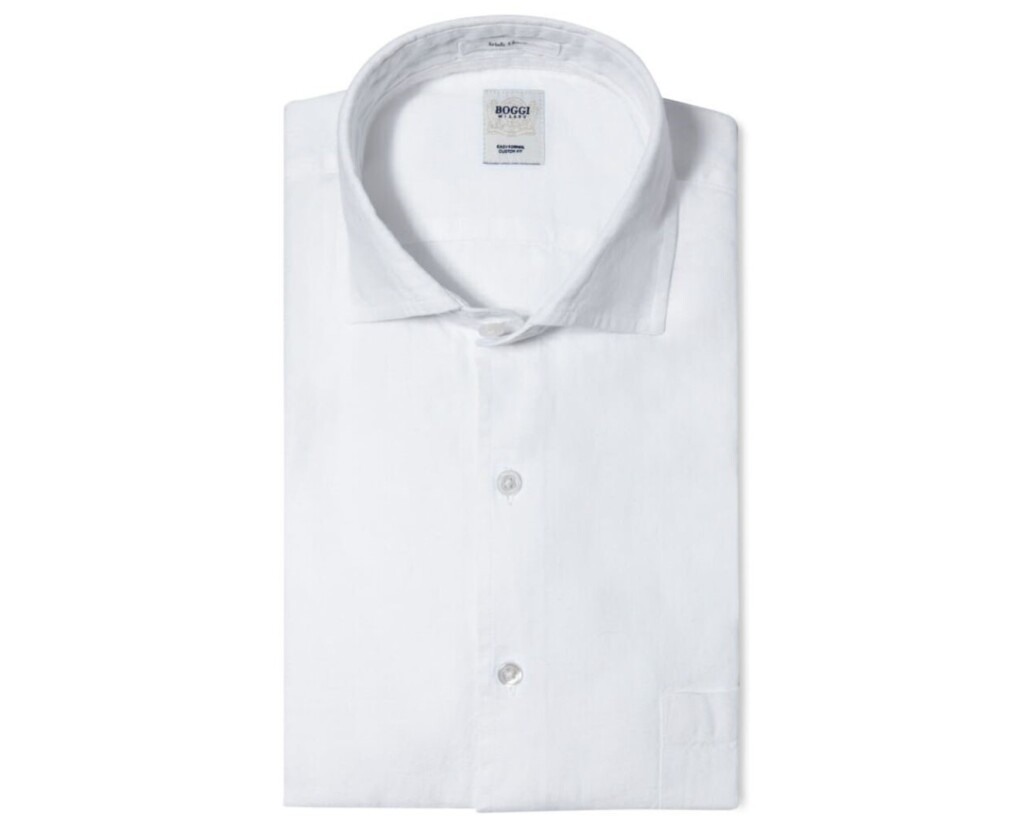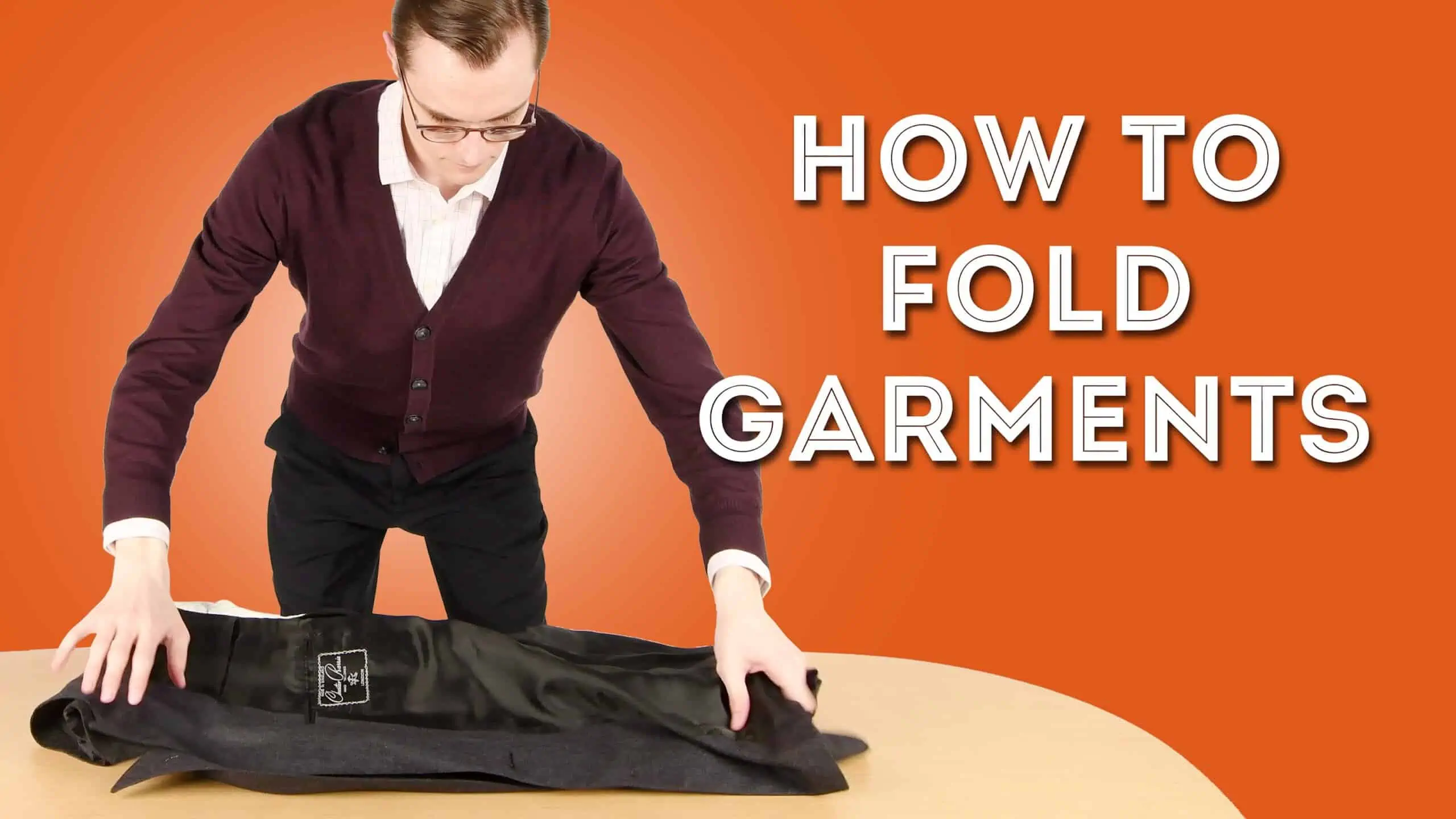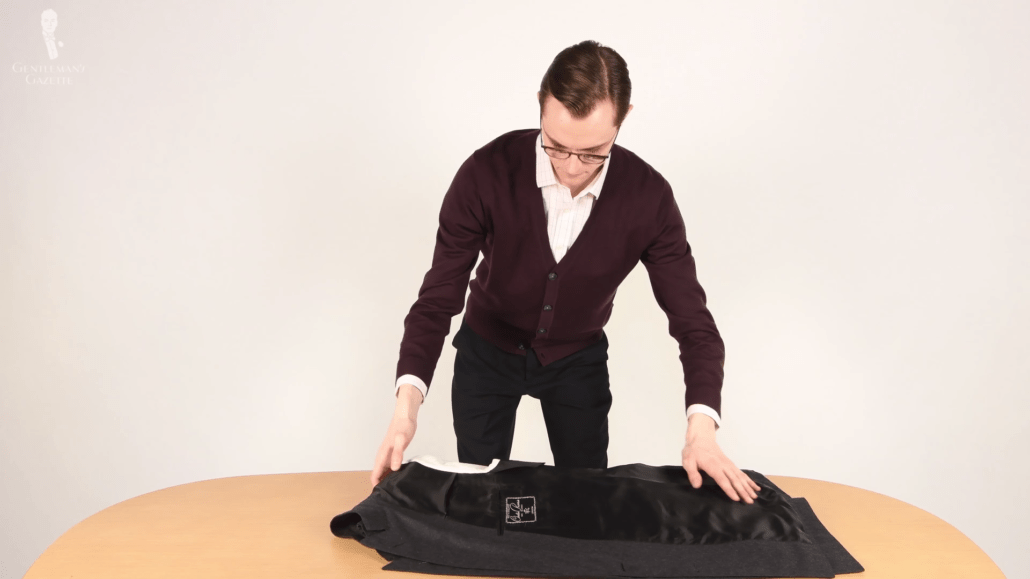Whether you’re looking to pack a suitcase efficiently for a vacation or just looking to maximize space in your own closet, knowing how to effectively fold different types of garments will be a handy tool in your sartorial arsenal. One quick note before we get to these specific methods today, there’s no one magic method that will completely eliminate wrinkles altogether, that’s just not how fabric works, however, the methods we’re outlining today will at least minimize wrinkles so that after you take your garments out again, a quick hit from an iron or garment steamer should get those wrinkles out.
Dress Shirts
- Start by laying your shirt flat on a table or other work surface and buttoning it up. Buttoning all the buttons is best for eliminating odd wrinkles but in a pinch, just buttoning the top button, bottom button, and a few buttons in the middle will be good enough.
- Flip the shirt over to the back side and gently run your hands over it a few times just to smooth out any potential wrinkles. Take one of the shirt sleeves and fold it over making sure to create a straight fold where the sleeve of the shirt meets the body at the armhole.

- Fold that sleeve upward at about a 60-degree angle so that the cuff is parallel to the top of the collar. Of course, you’re going to want to repeat these two sleeve folds with the other sleeve. Next, fold the entire shirt lengthwise into thirds making sure that all of your folds are straight and precise.
- Fold the shirt into thirds, width-wise, and that’s it! Alternatively, instead of folding widthwise, you could roll the shirt up from the bottom to the top. This might be a better storage solution for a carry-on or if you’re putting your shirts in a drawer. One additional tip, this folding method can also be used effectively for sweaters.
Pants & Trousers
- For pants with pleats and/or a central crease on the legs, start with the pants folded on that crease. Essentially, you can think of it as a side view of the pants. Also, to make sure things are aligned here, you can check that these seams are lining up at the bottom hems. Meanwhile for pants without a crease, like denim jeans, you can start with the pants laid flat on a table or work surface and simply fold them in half at the fly.
- Take the bottom hems and fold them about a third of the way up then fold again so that the bottom fold meets the waistband, that’s all there is to it! With pants, as with shirts, you can also roll from the bottom to the top instead of folding into thirds.
The Savile Row Fold
There is also another method of trouser folding that’s especially good for wrinkle prevention; if you want to hang your trousers in a closet, it’s sometimes known as the Savile Row fold after the street famous for fashions in London. Start as before with your pants folded either on the creases or at the center. Next, take the hanger you’re going to use, any material can be used, of course, but we do recommend that you avoid wire hangers and slide the hanger between the pant legs about halfway up the leg. Take the top leg and fold it under itself around the hanger with the bottom hem aligned with the crotch. Then lay the hanger and the leg flat, making sure that the leg isn’t bunched up under itself. Next, take the bottom leg and bring it through the opening in the hanger over the top. Now, your trousers are ready to hang and they’ll have fewer wrinkles.
Jackets & Sportcoats
This just might be the trickiest possible garment to fold, jackets. Why would this be the case? Simply put, it’s because the additional structural elements, like the lapels and possible shoulder padding that you might find in a jacket, are a bit more to deal with when folding.
- Start with the jacket unbuttoned and with its collar and lapels up. With the back side of the jacket facing up on your work surface, take the left shoulder or whichever side has a breast pocket and fold it back over the jacket about a third of the way.
- Take the right or opposite shoulder; carefully turn it inside out and bring it over the left. This may be easier to do while holding the jacket upright as opposed to on a work surface. The important thing is that these shoulders, lapels, and edges of the jacket should all meet up as cleanly as possible.
- Finally, you can either fold the jacket in half to store it flat or roll it up from the bottom to the top to eliminate one more potential wrinkle. There you have it! Your jacket is folded. This method can also be used effectively for overcoats but instead of folding the material in half at the end of the process, you can fold it into thirds or more to take care of some of that extra length effectively. Waistcoats can simply be folded in half lengthwise and then fold it into thirds or rolled from the bottom to the top to be effectively stored or packed.
CONCLUSION
With these folding techniques at your disposal then, your suitcase closet or chest of drawers should see a lot of additional space open up and your garments should only have a few wrinkles to deal with at whatever time you decide to unfold and wear them. Of course, we recommend storing your garments on high-quality wooden hangers for long-term storage.


Being careful about folding a wrinkled shirt?
you had used an ironed shirt, it would have made your point more effectively.
Being careful about folding a wrinkled shirt?
If you had used an ironed shirt, it would have made your point more effectively.
I have found the most wrinkle-free method of handling a shirt is to fold it carefully and place it into a 2 gallon plastic bag, squish the air out, seal it and pack it wherever you want it to go. The shirt will take any mishandling your travels will dish out, and will come out with only the fold marks if you were careful in folding. Garbage in is garbage out in folding as well. Smaller shirts will fit in smaller bags. Don’t waste money on specific packing packages. Plastic bags are less expensive and work far better.
I take your approach one step further – I take any shirts that are dry cleaned, keep the shirts in the dry cleaners cover, fold in half length-wise and then place in my suitcase. The shirts come look perfect when I unpack.
Any shirts not dry cleaned – I place in a used dry cleaning bag and again fold length-wise.
Preston,
Could you treat us to a song? I’m sure it would be most appreciated.
Amazing! Now I can pack my bags with epitomised efficiency! Thanks Gentleman’s Gazette!
You are welcome, Carl!
I really like the pants hanging technique. I never saw that one before but will try it, (I also really like that great looking brown jacket hanging behind you.) One question: Do you think folding a suit works better than using a hanging type garment bag?